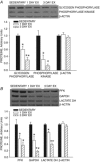PGC-1α mediates a rapid, exercise-induced downregulation of glycogenolysis in rat skeletal muscle
- PMID: 25416622
- PMCID: PMC4324710
- DOI: 10.1113/jphysiol.2014.283820
PGC-1α mediates a rapid, exercise-induced downregulation of glycogenolysis in rat skeletal muscle
Abstract
Key points: Long-term endurance exercise training results in a reduction in the rates of muscle glycogen depletion and lactic acid accumulation during submaximal exercise; this adaptation is mediated by an increase in muscle mitochondria. There is evidence suggesting that short-term training induces adaptations that downregulate glycogenolysis before there is an increase in functional mitochondria. We discovered that a single long bout of exercise induces decreases in expression of glycogenolytic and glycolytic enzymes in rat skeletal muscle; this adaptation results in slower rates of glycogenolysis and lactic acid accumulation in muscle during contractile activity. Two additional days of training amplified the adaptive response, which appears to be mediated by PGC-1α; this adaptation is biologically significant, because glycogen depletion and lactic acid accumulation are major causes of muscle fatigue.
Abstract: Endurance exercise training can increase the ability to perform prolonged strenuous exercise. The major adaptation responsible for this increase in endurance is an increase in muscle mitochondria. This adaptation occurs too slowly to provide a survival advantage when there is a sudden change in environment that necessitates prolonged exercise. In the present study, we discovered another, more rapid adaptation, a downregulation of expression of the glycogenolytic and glycolytic enzymes in muscle that mediates a slowing of muscle glycogen depletion and lactic acid accumulation. This adaptation, which appears to be mediated by PGC-1α, occurs in response to a single exercise bout and is further enhanced by two additional daily exercise bouts. It is biologically significant, because glycogen depletion and lactic acid accumulation are two of the major causes of muscle fatigue and exhaustion.
© 2014 The Authors. The Journal of Physiology © 2014 The Physiological Society.
Figures



References
-
- Ahlborg B, Bergström J, Ekelund LG. Hultman E. Muscle glycogen and muscle electrolytes during prolonged physical exercise. Acta Physiol Scand. 1967;70:129–142.
-
- Baar K, Wende AR, Jones TE, Marison M, Nolte LA, Chen M, Kelly DP. Holloszy JO. Adaptations of skeletal muscle to exercise: Rapid increase in the transcriptional coactivator PGC-1. FASEB J. 2002;16:1879–1886. - PubMed
-
- Baldwin KM, Reitman JS, Terjung RL, Winder WW. Holloszy JO. Substrate depletion in different types of muscle and in liver during prolonged running. Am J Physiol. 1973a;225:1045–1050. - PubMed
-
- Baldwin KM, Winder WW, Terjung RL. Holloszy JO. Glycolytic enzyme activities in red, white and intermediate skeletal muscle: Adaptive response to exercise. Am J Physiol. 1973b;225:962–966. - PubMed
-
- Booth FW. Holloszy JO. Cytochrome c turnover in rat skeletal muscles. J Biol Chem. 1977;252:416–419. - PubMed
Publication types
MeSH terms
Substances
Grants and funding
LinkOut - more resources
Full Text Sources
Other Literature Sources
Research Materials

